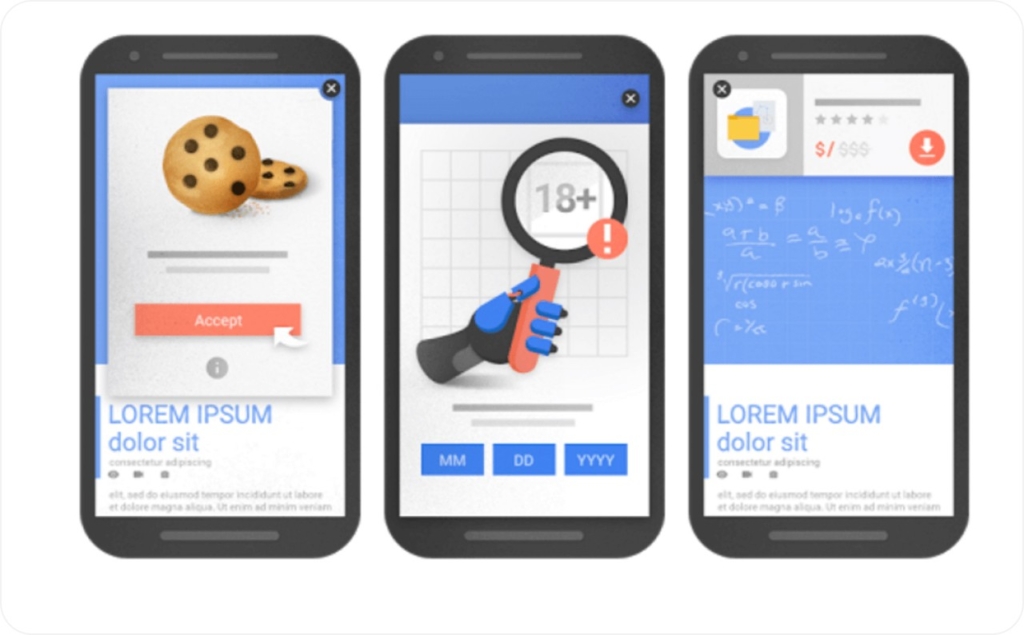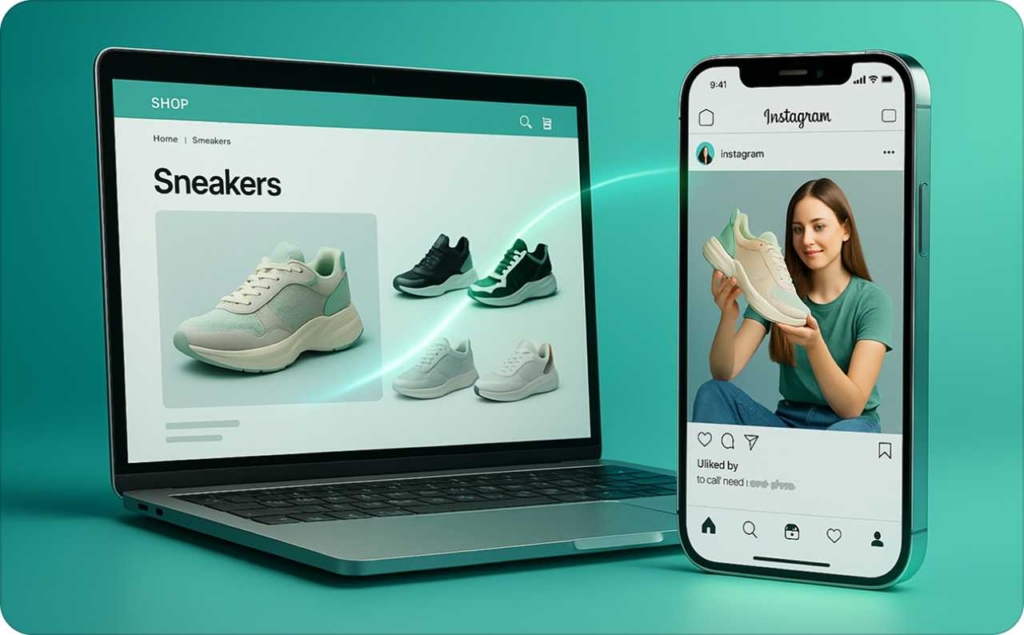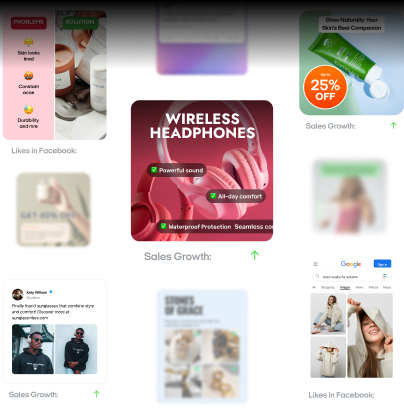What are interstitial ads? 4 types that help you balance revenue and customer trust
Worried about annoying users with pop-up ads? Zeely AI explains what interstitial ads are, their four main types, and how to use them effectively without breaking customer trust.
You’ve just beaten a tricky puzzle level. You’re about to see your final score. Then a full-screen ad appears, urging you to download another app. That’s an interstitial ad — a momentary takeover that appears during a natural pause.
These ads don’t lurk at the top or bottom like banners. They don’t interrupt you mid-sentence like pop-ups. Instead, they wait until you finish a level, load a new page, or switch app screens — making them feel less disruptive.
Interstitial ads pack a big punch in in-app advertising. According to Statista, global in-app ad spending may hit US$390.04 billion by 2025, partly because formats like interstitials command instant attention.
Some studies also show that interstitial ads can generate 5–10 times higher click-through rates than standard banners. That’s huge if you want to boost ad monetization or run user acquisition campaigns.

How interstitial ads work: Mechanics, placement, and timing
If you time an interstitial ad poorly, you’ll see more than a lost click — you’ll see higher user churn and negative reviews. Understanding how interstitial ads work at a deep technical level, and why precise placement and timing are essential, is the key to growing revenue without alienating your audience.
The mechanics behind an interstitial ad
If you’ve ever seen a full-screen ad appear between tasks, you might wonder how it got there so seamlessly. An interstitial ad doesn’t just pop up out of nowhere.
Behind each “tap to continue” moment, there’s a tight process of requesting, caching, and displaying the creative in a fraction of a second. Let’s break down that workflow.
Requesting and serving the ad
Everything starts when your app or website detects a transition point — like completing a game level, finishing a checkout, or moving to a new screen.
At that moment, it sends an ad request to a supply-side platform or ad network such as Google AdMob or Unity Ads. This request includes device details, user preferences, and session context.
Behind the scenes, real-time bidding or direct deals might determine which interstitial creative is served. The system weighs factors like eCPM, targeting parameters, and user segment. In milliseconds, it picks the highest bidder or best match and returns that ad to your app.
Caching and loading
Pre-caching ensures your interstitial is ready to display without lag. Static images typically load quickly, but video interstitials need more bandwidth and buffer time.
That’s why many apps start caching potential ads early — even when the user is still mid-level or mid-checkout. If the ad is fully cached, it appears instantly when triggered, preserving a seamless user experience.
Displaying the ad
When the user hits a logical pause, your app calls up the cached interstitial. A smooth fade-in or slide-in transition can reduce jarring effects.
Always include an easy-to-see close button. If people can’t dismiss the ad fast, you risk violating Google’s ad experience guidelines and harming your user experience metrics. Some advanced setups even track “time viewed” before the close button appears to balance engagement with user freedom.
Optimizing placement: Why timing matters
Showing an interstitial right after a significant action is the sweet spot:
- Games — once a player completes a level or mission
- Utility apps — post-task completion, like scanning a document
- E-commerce — after a successful checkout or on a thank-you page
Never interrupt critical user input like password entry or in-game movement. Misplaced ads feel like software glitches. Well-timed interstitials, on the other hand, can boost CTR by up to 40%, and they often lead to higher user receptiveness because you’re catching them between tasks.
Frequency capping: Avoid over-saturation
Frequency capping keeps you from overwhelming your audience with too many full-screen ads in a short window. Developers typically use two approaches:
- Session-based
Limit each user session to a set number of interstitials — often one interstitial every two minutes. Studies have found that repeatedly serving ads more frequently can cause a spike in negative reviews and app uninstalls. - Event-based
Trigger only one interstitial every two or three completed tasks. This prevents back-to-back interruptions that can feel aggressive or spammy.
Some apps take this further by using machine learning to tailor how often to show an interstitial, factoring in user behavior, session length, and churn risk. That’s advanced frequency capping, but even a basic cap significantly improves lifetime value.
UX risks and performance consequences
If you ignore timing or frequency limits, expect major backlash. Neil Patel notes that 91% of users find ads more intrusive than ever, with 87% saying the volume of ads has skyrocketed.
Show three disruptive interstitials in a single session, and you could trigger up to 60% higher abandonment rates. This doesn’t just kill revenue — app store rankings can tumble if negative reviews spike.

Photo source: Google
Why precision wins
A perfectly placed interstitial feels like a halftime break. It gives the user a moment to catch their breath and maybe check out an offer. But overdo it — even by a small margin — and you risk transforming a monetization strategy into a churn catalyst.
By mastering real-time bidding or direct network integrations, pre-caching ad creatives, and using frequency capping wisely, you turn these full-screen takeovers into some of your highest-performing revenue streams.
Types of interstitial ads: Formats and platform examples
You want to pick an interstitial ad format that captivates users instead of driving them away. If you get it wrong, you’ll waste money and hurt your brand reputation. But if you get it right, you’ll see a direct lift in click-through rates, installs, and even revenue. Let’s break down your main options.
Static interstitial ads: Clean, fast, and low-pressure
Static interstitial ads are single-image takeovers with a simple call-to-action. They load quickly and don’t usually disrupt your user’s flow — great for news sites, blogs, and any platform where speed is essential.
Even though they lack animation, AI static ads can yield a 20–30% higher CTR than banner ads, especially when you match your creative to your platform’s design.
For instance, if you run a productivity app, a seamless static interstitial might show a new organizational feature right after someone completes a task. The user is already in a “get things done” mindset, so they’re primed to click.
Of course, static ads won’t win any awards for excitement. If your audience needs a more dynamic nudge, you might consider a richer format. Still, for simplicity and low data usage, static interstitials get the job done.
Video interstitial ads: Immersive storytelling that sticks
Video interstitial ads let you tell a story in 15–30 seconds of fullscreen motion and sound. They’re designed to spark emotions, build brand recall, and drive deeper engagement.
It’s no wonder 86% of developers rely on in-feed video for app-install campaigns, citing it as the most effective format for driving downloads.
The key to AI video ads is pre-caching. If your clip stutters, users bail. Keep it short and punchy. Imagine you’re using a cooking app to find a dinner recipe.
Right after you pick one, a 15-second video showcases a meal delivery service and ends with a quick CTA. Users still in “food mode” are more likely to finish the video and explore the offer.
But video can be resource-heavy. Test your load times on both Wi-Fi and mobile networks. Also, confirm you’ve got the right format for your audience — an in-depth brand film might thrill entertainment app users, but it could scare off a productivity app crowd that wants something quick.
Rich media interstitial ads: Interactive experiences that spark curiosity
Rich media interstitials blend images, animation, and interactive features like sliders, quizzes, or tap-to-expand modules. They encourage active exploration instead of passive viewing. That’s why some advertisers see a 25% jump in click-throughs compared to basic image ads.
Take a beauty website, for example. Right after you review a set of lip gloss products, you get a swipeable interstitial showcasing different shades on a model’s lips.
You tap through, find your color, and hit “Buy Now.” This hands-on approach feels less like an ad and more like a mini-product experience.
The caveat? Rich media requires heavier assets and more dev time. If not carefully optimized, loading times can balloon. You don’t want users bailing because they’re stuck on a loading screen. But when executed well, rich media ads can offer a unique, memorable encounter that static or video ads can’t replicate.
Playable interstitial ads: The app demo that sells itself
Playable interstitial ads let you test-drive a mini version of a game or app before installing. They’re especially big in gaming, but you’ll also see them in fitness and education apps that thrive on user interaction.
Imagine you’re trying a language-learning app. A short quiz pops up in an interstitial — answer a few questions, get immediate feedback, then get invited to download the full version. You already feel engaged and curious. By the time you see the CTA, you’re sold on the concept.
This approach does demand more resources. You’re building a micro-experience that must run smoothly in various environments. If it’s glitchy or too long, you’ll kill any goodwill you just built. Keep the demo fun, intuitive, and relevant to the user’s current mindset.
How to pick the right format for your platform
Every interstitial ad format pairs well with a specific user mindset:
- Static ads if you want a fast, no-fuss solution that gently nudges user action
- Video ads if your story or brand identity thrives on visuals and emotion
- Rich media if you can delight users with interactive elements
- Playable ads if experiencing a mini-demo would inspire immediate installs
Focus on your audience, too. Cooking enthusiasts may enjoy short, lively videos; gamers might love a playable taste of what’s coming next.
By matching your ad experience to user expectations, you’ll lift CTR, spark conversions, and maintain positive user sentiment. That means more downloads, more sales, and a better user journey.
Key takeaways
- 1
Static interstitials
Deliver 20-30 % higher CTR than banners — fast, lightweight, reliable
- 2
Short video interstitials
Top download driver for 86 % of devs, if fully pre-cached.
- 3
Interactive & playable interstitials
Rich media adds ≈25% CTR, while mini-demos turn clicks into instant installs
Benefits & challenges of interstitial ads: Maximizing revenue without a user meltdown
If you want to earn more from your advertising, interstitials can be a game-changer. They seize the entire screen right when a user is most focused, and that can lead to a surge in clicks, conversions, and brand recognition.
But there’s also a downside. Mistime these ads, show them too often, or violate platform guidelines, and you risk irritating your audience — or worse, facing penalties from ad networks and app stores. Let’s explore how to get it right.
Why interstitial ads lift revenue and engagement
You’ll often see much higher eCPMs with interstitials compared to standard banner ads. While banners can hover around $0.50 or $1 per thousand impressions, interstitials in a popular mobile app or game might earn $3, $5, or even more. That’s a major jump in potential ROI, especially if you can maintain a steady flow of happy, engaged users.
According to Appsflyer, there’s no risk of banner blindness with an interstitial — you just can’t miss it. And the full-screen approach means advertisers have plenty of space to get their message across, even on a small phone screen. When users can’t ignore the ad, it naturally leads to stronger engagement.
These ads also pack a serious punch when it comes to click-through rates. Research from Smaato and Google AdMob shows interstitials can generate 5–10 times the CTR of traditional banners.
Users can’t simply glance away or scroll past them. They either click, close, or absorb your message — any of which is more likely to stick in their minds compared to a small banner at the bottom of a screen.
Brand recall tends to soar with full-screen experiences. Your campaign doesn’t just whisper in the background; it takes center stage.
That’s why Candy Crush Saga, for instance, chooses to serve interstitial ads between levels. You’re already pausing, so the ad feels natural. You notice it, and you remember it later.
If you’re managing a social media ads campaign or paid media strategy, this effect can extend across platforms. People who see your message full screen might be more likely to engage with your brand’s social channels or tell friends about their experience. In a crowded digital space, that extra recollection can set you apart.

Photo source: Google
Where interstitial ads can backfire
Despite these upsides, interstitials can backfire if you don’t handle them carefully. Imagine you’re midway through playing a mobile game or reading an article, and an ad suddenly hijacks your screen. It feels disruptive, like someone slamming a door mid-conversation. When that happens too often, users bounce.
Watch for early warning signs of user frustration. A higher bounce rate, shorter sessions, or a spike in one-star reviews can signal that something’s wrong. If you see these shifts, it’s time to revisit your placement strategy.
Policy compliance is another big concern. Google AdMob, Chartboost, and other major ad networks have detailed rules for interstitials. Ads must appear at logical breakpoints, include a visible close button, and load quickly.
Google’s Mobile Ad Policy specifically warns against “unexpected” or “intrusive” experiences. If you cross that line, you could lose your ad privileges — or worse, get demoted in search rankings or app store listings.
How to dodge the “overkill” trap
Don’t overload users with too many interstitials in a single session. Limit them to once every couple of user actions or pages.
This frequency prevents your audience from feeling spammed. Some publishers even space them out across multiple visits so people don’t feel bombarded every time they open your app or website.
Pay attention to user feedback, not just raw data. A user might be okay with one ad in a ten-minute session, but if you serve three ads in that same timespan, they might uninstall your app or bounce from your site forever.
Test different timing strategies. See when your users are least likely to abandon and most willing to engage. If you’re running A/B tests, compare how interstitial frequency affects your retention metrics over the course of a week or month.
Making interstitials feel user-friendly
You can still earn serious revenue without driving people away. First, preload your interstitial ads before you plan to display them. That way, users aren’t staring at a loading screen, wondering what’s going on.
Make sure the ad’s close button is clear and easy to tap. People won’t resent an ad if it appears at a logical pause and they can exit quickly.
Timing matters. If you’re publishing a mobile game, consider showing an interstitial after a level is completed or before a new stage loads.
If you’re running a news site, try displaying one after a user finishes an article. These breaks feel natural, so the ad experience feels less jarring.
Picking the right ad network also makes a difference. Google AdMob and Chartboost have strong track records for mobile apps.
Unity Ads is often preferred for gaming environments. Each network has its own pros and cons, from fill rates to payout structures, so test a couple to see which delivers the highest returns.
Monetization & revenue potential of interstitial ads
If you’ve ever watched your revenue trickle in and wondered how to scale, you’re not alone. Interstitial ads can help you jump from trickles to torrents — if you use them wisely.
These full-screen placements capture your users’ complete attention, which often leads to higher clicks, conversions, and, ultimately, better profits. Let’s explore how much you can really earn, the benchmarks to hit, and the specific tactics that drive success.
How much revenue can interstitial ads generate?
Interstitial ads typically outshine banners for a simple reason: focus. When an ad fills the entire screen, there’s nowhere else for the eye to go.
That’s why eCPMs for interstitials often range from $3 to $6 worldwide, sometimes hitting $8–$12 in places like North America or Western Europe. Banners, by comparison, may struggle to pass $1 — even on a good day.
Finance apps, gaming platforms, and digital newspapers often see 30–50% of their total ad earnings tied directly to interstitials. Even though these apps usually serve fewer interstitials than banners, the revenue impact is bigger because engagement spikes during those full-screen moments.
If you show an interstitial at just the right time — say, right after a user completes a puzzle level or finishes a news article — you’ll catch them when they’re between tasks, not in the middle of something important.
What benchmarks and ROI can you expect?
If your interstitial click-through rate is sitting at 1% or below, you’re likely missing a golden opportunity. Most publishers aim for a 2–5% CTR on interstitials, and it’s not unusual to break past $10 eCPM in high-demand regions. Return on ad spend can climb 20–40% above what standard banners offer.
The best ways to maximize interstitial ad revenue
The power of interstitials comes from combining smart timing, good network partnerships, the right ad format, and personalization. Your goal is to present full-screen ads that feel like part of the flow — never like a roadblock.
Timing is everything
Don’t interrupt a crucial action or break your user’s focus mid-level. Wait until they’ve just accomplished something or are switching gears. In a game, serve the interstitial after a win.
On a website, show it after someone finishes reading an article. If you hammer users with full-screen ads every time they tap, your retention could plummet.
Pick good ad networks or use mediation
Networks like Google AdMob, Chartboost, and IronSource fine-tune bids in real time to boost your eCPM. For even higher fill rates, you can try mediation platforms like AppLovin MAX.
These platforms juggle multiple networks at once, which often drives up competition for your ad slots — and raises your revenues.
Test multiple formats
Don’t stick to one type of creative. You might find your audience responds well to playable interstitials, where users can preview a mini-game, or short video ads that show a quick product demo. Watch metrics like bounce rate and session length to confirm your ads aren’t chasing people away.
Segment your users
All users aren’t alike. Reward loyal users or power spenders with premium campaigns, while new or casual users might see simpler ads. Personalization can lift click-through and conversion rates dramatically.
Sustainable growth and the future of interstitial ads
According to GlobeNewswire, the interstitial ads segment may grow at 15.7% CAGR between 2024 and 2032, making it one of the fastest-rising digital ad categories.
That growth signals strong demand from advertisers — demand you can tap into by refining your ad creatives.
If you build a user-friendly environment for interstitials, they’ll reward you with stronger revenue streams and better user engagement over time.
Conclusion & future trends: Key takeaways and what’s next for interstitial ads
If you see interstitial ads as a short-term fix, you’re missing a bigger opportunity. Full-screen placements are evolving quickly, and the marketers who adapt now can turn user attention into steady revenue.
Key takeaways: Driving results by respecting users
You’ve learned that interstitial ads thrive when they fit naturally into the user experience. Show them right after a game level ends or once someone finishes reading an article.
Focus on load times so you’re not keeping anyone waiting, and cap the frequency to avoid wearing out your welcome. If bounce rates climb or session lengths drop, that’s your signal to refine your timing or creative.
Beyond clicks, keep an eye on overall ROI. Tracking long-term value tells you more about success than a single metric like eCPM. By looking at retention, churn, and multi-touch attribution, you’ll see the true impact of your ads.
Also recommended



